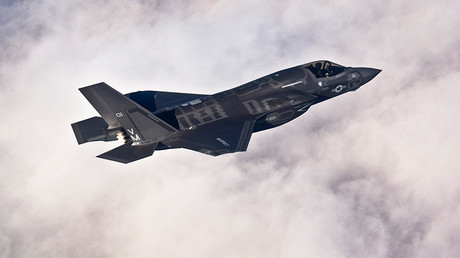‘Degrading’ F-35 nothing to worry about, despite GAO report – Pentagon
The Pentagon has conceded that congressional watchdogs were “factually accurate” when they reported that the F-35 program is facing sustainability challenges but remain adamant that everything is under control.
The Government Accountability Office (GAO) released a report Friday, stating that the Department of Defense’s (DoD) F-35 Joint Program Office (JPO) is “facing sustainment challenges that are affecting warfighter readiness.”
The review said the Pentagon’s ability to repair F-35 parts at military depots are six years behind schedule, resulting in an average repair time of 172 days, twice the program’s objective.
It added that the DoD is experiencing a shortage in spare parts, which has been “degrading readiness,” and that a parts shortage has led to around 22 percent of F-35’s not being able to fly from January to August this year.
The inability to have regular flights has made it difficult for the Pentagon to enter into a performance-based sustainment contract with the prime contractor, Lockheed Martin, since they have not been able to achieve a “desired aircraft performance under pilot” in the trial period.
The report states further that the F-35s scheduled to deploy on ships in 2018 do not have the intermediate-level maintenance capabilities that would allow the Marine Corps and Navy to make repairs to the aircraft at sea. GAO says the Pentagon does not have to funds in place to achieve those capabilities.
While GAO says the Pentagon has “taken some actions to try to reduce estimated sustainment costs for F-35 operating and support,” it estimates that the life cycle costs of the aircraft have increased over the past few years, and are “not fully transparent to the military services.”
The document cites the Marine Corps, which received an initial funding requirement of $293 million, which increased to $364 million over the course of the execution year.
The DoD currently has a fleet of over 250 F-35 aircraft and plans to triple that number by the end of 2021, the report said. However, without better sustainment plans, the Pentagon “risks being unable to fully leverage the F-35’s capabilities and sustain a rapidly expanding fleet.”
GAO recommended that the DoD should “revise sustainment plans, re-examine metrics and ensure that it has sufficient knowledge of costs and technical characteristics before entering into performance-based contracts, and improve communication with the services about sustainment costs.”
In response, F-35 spokesman Joe DellaVedova told RT America the GAO report is “factually accurate,” but argues that the report did not take the program’s depot capability and capacity acceleration into account.
“There were no surprises in the report and all of the issues mentioned are well known to the JPO, the US Services, International Partners and our industry team,” DellaVedova told RT America. “In fact, the program already had actions in work for all of the GAO’s recommendations to improve readiness and increase transparency.”
DellaVedova said the JPO has spent $1.4 billion to bolster their repair capacity and improve repair times. He also said the Pentagon spent $114 million to accelerate deport capability and invested $3.4 million in “28 reliability and maintenance improvement projects,” in order to reduce the most expensive drivers of maintenance costs.
“Examples of [reliability and maintenance] initiatives include using existing support equipment to service F-35s, flattening supply chains to expedite spare part delivery, introducing new technologies that accelerate maintenance processes, consolidating recurring maintenance requirements, and incorporating feedback from maintainers and depot-level artisans to improve procedures,” DellaVedova said in an email to Inside Defense.
He added that the F-35s Autonomic Logistics Information System (ALIS), a tactical aviation system that collects information on the aircraft, will be their “technical roadmap to address future requirements.”
“This plan will be updated annually to reflect new and updated requirements to remain cyber secure, technologically current, and minimize life cycle cost,” DellaVedova wrote.




